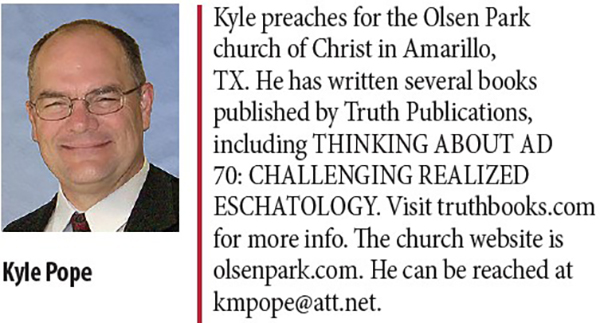
by Kyle Pope
Synopsis: The popular “transition verse” view of Matthew 24 is held by many brethren in opposition to Premillennialism and Full-Preterism, but are there challenges it presents to the sound interpretation of this text?
Among many brethren, a common interpretation of the Olivet Discourse considers Matthew 24:34 a “transition verse” from addressing only the destruction of Jerusalem before it to discussing only final judgment after it. Many see this as a way to avoid the extremes of premillennial views (that imagine a future rebuilt temple and its future destruction) or full-preterist views (that consider the entire discourse as only dealing with the destruction of Jerusalem in AD 70). In this and my next article for this column, we will test this interpretation.
If the transition-verse view is correct, some compelling language that precedes 24:34 cannot be taken literally but must be interpreted as figurative apocalyptic language describing the significance of God’s judgment on Jerusalem. Certainly, Scripture sometimes uses cosmological end-times language in non-literal ways but in this case, it presents some challenges that I fear some may not have considered.
Matthew 24:29-33 describes: the sun and moon darkened, stars falling, and the powers of the heavens being shaken (v. 29), tribes of earth mourning (v. 30a), all seeing the Son of Man (v. 30b), the Son of Man coming on clouds (v. 30c), coming with power and glory (v. 30d), coming with the angels (v. 31a), the sound of a trumpet (v. 31b), and a gathering for judgment (v. 31c).
These same events are described elsewhere in the New Testament in literal descriptions of Christ’s coming in final judgment. For example: Cosmological events (Matt. 5:18; 24:35; Mark 13:31; Luke 21:33; 2 Pet. 3:10, 12; Rev. 20:11; cf. Rev. 21:21), tribes of earth mourning (Rev. 1:7), all seeing Him (Matt. 24:27; Luke 17:24; 1 Cor. 1:7; Col. 3:4; 1 Tim. 6:14; 2 Tim. 4:1, 8; Titus 2:13; 1 Pet. 1:7, 13; Rev. 1:7), the Son of Man coming on clouds (Matt. 26:64; Mark 14:62; Acts 1:9-11; 1 Thess. 4:17; 2 Thess. 2:1; Rev. 1:7), coming with power and glory (Matt. 16:27; 25:31; Mark 8:38; Luke 9:26; cf. Matt. 19:28; 2 Thess. 1:9-10; Col. 3:4; 1 Pet. 1:7; 4:13; 5:1), coming with the angels (Matt. 13:41; 16:27; 25:31; Mark 8:38; Luke 9:26; 2 Thess. 1:7; 1 Thess. 4:16), the sound of a trumpet (1 Cor. 15:52; 1 Thess. 4:16), and a gathering for judgment (Matt. 3:12; 13:30, 40, 41; 13:47-48; 16:27; 25:32-33; John 15:6; 2 Thess. 2:1; Rev. 20:12-13).
If these events are literal in other texts, why should we take them figuratively in Matthew 24:29-33? If they are figurative in Matthew 24:29-33, why shouldn’t we take them figuratively in all the New Testament? Does their literal application in other texts tell us how New Testament writers interpreted Jesus’s words in Matthew 24:29-33? These are important questions to answer. In my understanding, two things lead brethren to this conclusion: (1) how we interpret the phrase “all these things” in 24:34, and (2) how we interpret “immediately” in 24:29.
Matthew 24:34 reads: “Assuredly, I say to you, this generation will by no means pass away till all these things take place.” The argument is that “all these things” must indicate that everything described before this verse will “take place” within the lifetime of the first-century “generation” to whom Jesus was speaking. If this is correct, all the events described in 24:29-33 must be included within the phrase “all these things.” We have already seen that this view would demand taking events described in these verses figuratively (of AD 70) that are elsewhere applied literally to Jesus’s Second Coming, but there are additional problems with this view.
After Jesus begins to answer the disciples’ question, “When will these things be?” (Matt. 24:3b; cf. Mark 13:4a; Luke 21:7b), we often miss that Jesus tells them more about what they would NOT SEE than He does about what they WOULD SEE. Or, more precisely, He tells them what they would see that would not signal “the end” and what they would see that would demand action. Notice, He says they must “take heed (blepō) that no one deceives you” (24:4b). The Greek word blepō means “to see, discern, of the bodily eye” (Thayer). It is one of several Greek words that describes vision. Let’s notice the emphasis throughout this section on what He said they would and would not “see.”
In 24:5-12, He tells them they would see: false christs (v. 5), wars and rumors of wars (v. 6a), conflict between nations and kingdoms (v. 7a), famines, pestilences, and earthquakes (v. 7b), persecution and hatred toward Christians (v. 9), stumbling, betrayal, and hatred (v. 10), false prophets (v. 11), and falling away (v. 12). Yet, He tells them these things were not to be interpreted as “the end” (v. 6b). It is not until 24:15-22 that He first tells them of anything they could expect to “see” that relates to any portion of their question and upon which they should act. He declares, “Therefore when YOU SEE the ‘abomination of desolation,’ . . . then let those who are in Judea FLEE to the mountains” (vv. 15-16, emphasis mine). It is this event that He calls an unparalleled time of “great tribulation” (v. 21). Without question, this is talking about AD 70. After this, in 24:23-28, He returns to warning them again not to be deceived, again spelling out what they would see and what they would not see.
There are many reasons why I reject the AD 70 Doctrine with its false conclusion that the Lord’s Second Coming was accomplished in AD 70. One big reason is because verse 23 tells me not to! Notice: “Then”—when? At AD 70, at the time of the “great tribulation.” Jesus then says, “If anyone says to you, ‘Look, here is the Christ’. . . DO NOT BELIEVE IT” (emphasis mine). Jesus says not to believe claims that say, “Here is Christ, in the events of AD 70!” Does that only apply to claims made by those living during AD 70? No. Does it only apply to false christs that pretended to be Christ in AD 70? No. He even addresses the unseen claims: “Therefore if they say to you, ‘Look, He is in the desert!’ do not go out; or ‘Look, He is in the inner rooms!’ DO NOT BELIEVE IT” (v. 26, emphasis mine). To argue that AD 70 was the second and final coming of Jesus is a direct contradiction of the Lord’s commands in Matthew 24:23! It would have us believe that “then,” although many other false christs came whom they should reject, we should believe at least one claim that says, “Here is the Christ, in the events of AD 70.” I can’t do that!
To accept this view, we also have to ignore His very next words: “For as the lightning comes from the east and flashes to the west, so also will the coming (parousia) of the Son of Man be” (24:27). Lightning is unmistakable. Everyone sees it. Even those sitting in a house will see the flash from “east” to “west.” The very fact that we still discuss whether AD 70 was the “coming (parousia)” of Jesus shows that it could not have been! Jesus says that when it happens, like lightning, it will be unmistakable. The fourth century preacher, John Chrysostom, a native of Syrian Antioch, to whom ancient Greek was his native language, wrote of this passage:
How then doth He Himself come? “As the lightning cometh out of the east, and shineth even unto the west, so shall also the coming of the Son of Man be”. . . How then shineth the lightning? It needs not one to talk of it, it needs not a herald, but even to them that sit in houses, and to them in chambers it shows itself in an instant of time throughout the whole world. So shall that coming be, showing itself at once everywhere by reason of the shining forth of His glory (Homily 76, on Matt. 24:16-18.3).
Lord willing, I plan to discuss the Olivet Discourse at Truth Lectures this summer. In the material that I plan to present, I will explore the meaning and use of the word parousia, translated “coming” in this verse and elsewhere in the New Testament. I will argue that, by using this word, Jesus could not have chosen a term that makes it any clearer that His coming would involve an actual, literal, visible presence of Jesus Christ that, like His first coming, will also be an actual, literal, visible presence (see 2 Pet. 1:16). That did not happen in AD 70! To argue otherwise is to take a word with no demonstrable biblical or extra-biblical examples of being used in a figurative or representative manner and force a meaning upon it that is foreign to its usage in ancient Greek.
How then should we understand the scope of the phrase “all these things” in Matthew 24:34? The verse right before it says, “So you also, when you SEE ALL THESE THINGS, know that it is near—at the doors!” (v. 33, emphasis mine). He is talking about things they could “see,” or see that would not signal the end. He is not talking about things they would not (or could not) see. Again, what would they see? False christs (v. 5), wars and rumors of wars (v. 6a), conflict between nations and kingdoms (v. 7a), famines, pestilences, and earthquakes (v. 7b), persecution and hatred towards Christians (v. 9), stumbling, betrayal, and hatred (v. 10), false prophets (v. 11), and falling away (v. 12), but these things were not to be interpreted as “the end” (v. 6b). They would “see” the “Abomination of Desolation,” or as Luke explains, “But when YOU SEE Jerusalem surrounded by armies, then know that its desolation is near” (Luke 21:20, emphasis mine). When they saw this, they were to “flee.” These are the things He says they would “see,” not the events of Matthew. 24:29-33.
I fear that brethren have overlooked a major problem that this creates. The transition-verse view must argue that the events of 24:29-33 were fulfilled in an unseen figurative way in AD 70, but it must also include them within “all these things” in 24:34. The problem is Jesus says “all these things” are things they would “see” (24:33), so unseen things cannot be included within “all these things” if they could not be seen. We can’t have it both ways. In the next article, we will explore the second element important to the transition-verse view—the use of the term “immediately” in 24:29. 


